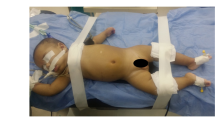Abstract
Over a period of 5 years, we analyzed our data on outcome, feasibility, and safety of Minimal Access Surgery (MAS) in 211 children. The outcome was compared objectively with age matched controls with similar diagnosis undergoing open surgery over the same period. There was no significant difference between mortality, morbidity, re-exploration rates and analgesic requirement between MAS and open surgery. There was a significant difference in the length of stay in hospital, in favour of laparoscopic cholecystectomy, appendectomy, nephrectomy, splenectomy, surgery for intra-abdominal testis compared to open surgery but not for children undergoing surgery for appendicular perforation and intestinal pathology. All parents preferred the cosmetic outcome of minimal access surgery.
Similar content being viewed by others
References
Udwadia TE. Laparoscopy in India-A personal perspective. J Minim Access Surg. 2005;1:51–52.
Oak SN, Parlekar SV, Akhtar T. Minimal access surgery in children-5 years institutional experience. J Minim Access Surg. 2005;1:121–128.
Saravanan K, Kumaran V, Rajamani G. Minimally invasive pediatric surgery: our experience. J Indian Assoc Pediatr Surg. 2008;13:101–103.
Lee SL, Yaghoubian A, Kaji A. Laparoscopic vs open appendectomy in children: outcomes comparision based on age, sex and perforation status. Arch Surg. 2011;146:1118–1121.
Sauerland S, Jaschinski T, Neugebauer EA. Laparoscopic versus open surgery for suspected appendicitis. Cochrane Database System Rev. 2010;6:CD001546.
De U. Laparoscopic versus open appendicectomy: An Indian perspective. J Minim Access Surg. 2005;1:15–20.
Deepak J, Agarwal P, Bagdi RK. Paediatric cholelithiasis and Laparoscopic management: A review of twenty two cases. J Minim Access Surg. 2009;5:93–96.
Clark JM, Koontz CS, Smith LA. Video assisted transumblical Meckels diverticulectomy in children. Ann Surg. 2008;74:327–329.
Schier F. Laparoscopic inguinal hernia repair-a prospective personal series of 542 children. J Pediatr Surg. 2006;41:1081–1084.
Alzahem A. Laparoscopic versus open inguinal herniotomy in infants and children: A meta-analysis. Pediatr Surg Int. 2011;27:605–612.
Kirsch AJ, Escala J, Duckett JW. Surgical management of nonpalpable testis: The Children’s Hospital of Philadelphia experience. J Urol. 1998;159:1340.
Gundati MS, Patel Y, Duffy PG. An initial experience of 100 paediatric laparoscopic nephrectomise with transperitoneal or posterior prone retroperitoneoscopic approach. Pediatr Surg Int. 2007;23:795–799.
Murawski M, Patkoswki D, Korlacki W. Laparoscopic splenectomy in children-a multicenter experience. J Pediatr Surg. 2008;43:951–954.
Author information
Authors and Affiliations
Corresponding author
Rights and permissions
About this article
Cite this article
Chowdhary, S.K., Kandpal, D. Minimal access surgery in children: A 5 year study. Indian Pediatr 49, 971–974 (2012). https://doi.org/10.1007/s13312-012-0246-7
Received:
Revised:
Accepted:
Published:
Issue Date:
DOI: https://doi.org/10.1007/s13312-012-0246-7




